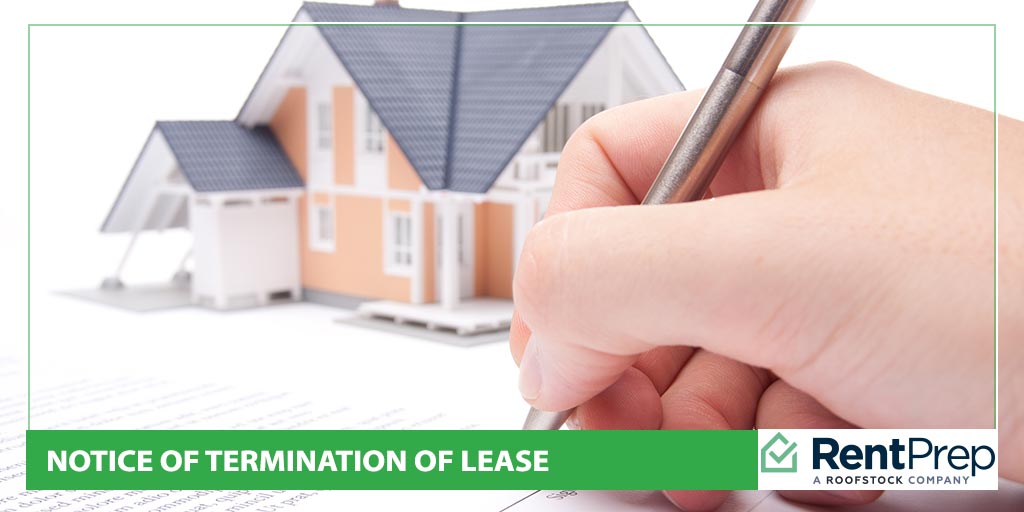

A lease termination notice is a formal document sent to a landlord or tenant to end the lease agreement.
There are a variety of reasons why a tenant or landlord may elect to terminate a lease, such as non-payment of rent, breach of lease terms, or other legal issues. Understanding how to write a lease termination letter can help avoid potential disputes and legal complications.
We created this comprehensive guide to assist you in crafting this letter. Download our free lease termination letter template and follow our step-by-step instructions to help facilitate a smooth and transparent termination process.
Our free lease termination letter template is designed to be customized and will fit various termination scenarios to meet your specific needs.
Here are the most common types of termination notices and scenarios where each might be used:
Typically, many state laws require a standard 30-day notice period for month-to-month leases.
This notice is for ending a lease that has a defined end date.
Either the tenant or landlord can send this notice to terminate the lease before the end of the term. However, it must meet the specific conditions in the lease agreement.
Sent by a landlord when a tenant has violated lease terms, this notice offers renters a chance to correct the issue or vacate the property.
This termination notice specifically addresses situations when the tenant regularly fails to pay rent as agreed.
When a property owner sells the rental and the new owner requires any tenants to vacate, this is the letter sent.
Eviction is a legal process initiated when a tenant fails to comply with the lease terms or other legal requirements.
Your lease termination letter should include several essential details:
As a landlord, writing a lease termination letter requires careful attention to detail for clear communication and compliance. This step-by-step guide can help you create a concise and effective notice.
For clarity and formal recognition, begin by identifying both parties involved, clearly stating your full legal name and the tenant’s full name. For example, “Dear [Tenant’s Full Name], this letter is to inform you that I, [Your Full Name], am providing notice to terminate the lease.”
Next, specify the exact location of the rental property to help eliminate any potential confusion. For example, “This notice pertains to the property located at [Full Property Address].”
Be sure to add the date you are writing and sending the letter, such as, “This notice is dated [Current Date].” That helps establish a record of when you issued the notice.
Indicate the exact date you expect the tenant to vacate the property and confirm the date aligns with the notice period required by your lease agreement or local laws. You could write, “You are required to vacate the premises by [Termination Date].”
Briefly explain why you’re terminating the lease, whether due to non-compliance with lease terms, sale of the property, or another reason. A clear explanation offers transparency. For instance, “The reason for termination is [Reason], as per our previous discussions.”
To help ensure both parties are on the same page regarding timing, clarify the length of the notice period you are adhering to, as stipulated by your lease agreement or state laws, such as, “This notice fulfills the [X]-day notice period required by our lease agreement.”
Be specific about the steps a tenant should take before moving out, including cleaning, returning keys, and scheduling a final inspection. For example, “Before vacating the premises, please ensure the property is cleaned thoroughly, and return all keys to the leasing office. Contact me to schedule a final inspection.”
Inform the tenant about how you handle security deposits, when they can expect their deposit to be returned, and address any potential deductions. Setting clear expectations helps minimize disputes. For instance, “Following the move-out inspection, we will process your security deposit return. Please note that deductions may be made for any damages beyond normal wear and tear.”
End your letter with a thoughtful closing statement, thanking the tenant for their cooperation. A respectful tone helps maintain good relations. For example, “Thank you for your understanding and cooperation.”
Sending a lease termination letter involves more than just drafting the document. Here are some best practices to consider:
Can a landlord terminate a lease?
Yes, a landlord can terminate a lease as long as it’s done following the lease terms and applicable state laws and valid reasons are provided, such as non-compliance or property sale.
How do you end a lease agreement?
To end a lease agreement, furnish written notice to the tenant specifying the termination date, reason for termination, and any required actions before vacating.
When do you give notice on a rental property?
Notice should be given according to the lease agreement and local laws, typically 30 to 90 days before the desired termination date.
How do you give a 30-day notice to a tenant?
Deliver the notice in writing through certified mail, clearly stating the termination date and any necessary steps the tenant must take.
How do you write a letter to terminate a lease agreement?
Include the tenant’s name, property address, termination date, reason for termination, move-out instructions, and security deposit information, maintaining a professional tone throughout.
Is terminating a lease the same as eviction?
No, terminating a lease is a mutual end to the lease agreement, while eviction is a legal process initiated due to significant lease violations or non-payment of rent.
Do you have to give a 30-day notice on a month-to-month lease?
Yes, most states require a 30-day notice for terminating a month-to-month lease, but always check your local laws for specific requirements.
Our tenant screening services have been trusted by over 100,000 landlords & property managers since 2007. SEE OUR PACKAGES
Starting at just $21.00!